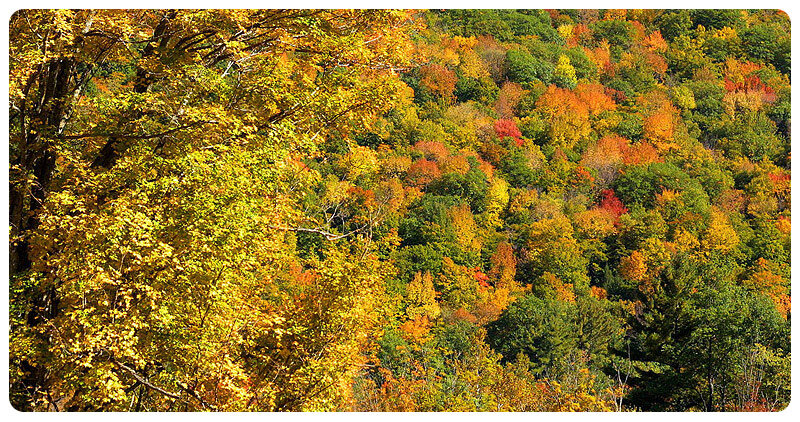A Walk on the Wild Side
Just 160 kilometres northwest of one of the busiest and most congested cities in the world, over 1,000 black bears lurk in the wilderness, coyotes taunt and terrify domestic cats and mountain lions stalk their prey.
The road to wilderness from New York City is surprisingly simple. Head north on the Henry Hudson Parkway taking care to avoid the yellow taxis erratically changing lanes. Drive straight over the George Washington Bridge and within two hours of the skyline disappearing from view you’ll be in bear country.
The Catskill mountains encompass over 9,000 square kilometers and are often referred to as America’s first wilderness because scholars trace the beginnings of the environmental conservation movement to this area.
Next, leave Interstate 87 for route 28 which passes near Woodstock.This small town that embraced a generation of artists and musicians is still a colourful melting pot.The residents, some no doubt who were once poor musicians in the 1960s and have done decidedly well for themselves, campaign vigorously to keep the atmosphere unchanged. There are no traffic lights, no chain stores and absolutely no mobile phone transmitters.
Woodstock’s real treasure though is Overlook Mountain; the path to it lies up a winding road opposite a gold and red Tibetan Buddhist monastery. The impressionist Thomas Cole chose to come to Overlook Mountain on his last visit to the Catskills in October 1847, a few months before his death. The mountain also inspired what critics say is Bob Dylan’s greatest work, when he lived in a big, pink barn-style house beneath the eastern slope. It was here the album appropriately named, ‘Music from Big Pink,’ was written. Just two days before the 1969 music festival that was in fact held in the tiny village of Bethel, far south of Woodstock, Dillon left town. He was horrified at the thought of the thousands of fans descending on the area just an hour from his home. Overlook Mountain inspired another famous resident,Van Morrison who released the quintessential Woodstock album, Tupelo Honey, which flashed romantic images of life in ‘Old, Old Woodstock.’
At first the walk up the mountain with such a noble pedigree inspires great delight. But soon the steep climb becomes laborious.Trees block out any view and it’s an hour before we come across the old ruins of Overlook Mountain House, a rather sad reminder of grander days but an indication that the summit is near. It was once a fine hotel hosting a curious mix of the rich and famous and folk who believed the air held a healing property that could cure all ills. It boasted the highest elevation of any New York state mountain house at the time and each table had its own waiter.Even the President Ulysses S. Grant paid a visit.
Unfortunately the President got drunk on the trip up the Hudson River and continued to drink on the bumpy stagecoach ride to the top of the mountain. By the time he arrived he had to be put to bed. The resort was branded an evil booze-guzzling joint by those in the American temperance movement.In 1924, long after its heyday, a fire destroyed the hotel and it now lies in an undignified state of disrepair.
It is not until we reach the rock face that the Hudson Valley sweeps into view. The panorama must be one of the most spectacular in the world. Seven vultures circle the forest below us then spying our perch they fly past to take a closer look. Never before have I envied a vulture. But looking down on them flying over the Hudson River, through the valleys of the imposing Shawangunk Mountains and over the Ashokan Reservoir, I feel they must have a fine life.
A white dot stands out against the mountain’s green backdrop. It is an albino red-tailed hawk. This rare bird sits conspicuously on a tree for ten minutes then swoops into the valley without reappearing. Native American legends hold the white animals as sacred. Some locals believe this exceptionally rare albino bird indicates change is going to come about.
Our cabin is the last property on Ticetonyk Mountain. Hidden in the forest we have few neighbours. And of course there are the bears. We’re not sure how many live in the 300 hectares of forest behind the cabin, they are discreet visitors. In the winter their huge footprints would occasionally appear close to the cabin, so we thought it wise to consult an expert on how best to deal with a bear encounter.
New Hampshire resident Ben Kilham is the ultimate authority on bears. Having raised 285 orphan bears he has a unique insight into their complex social network.
‘Always look a bear right in the eye,’ Ben advises. ‘It’s all a question of who thinks they have the dominant position. The second you take your eyes off a bear he will take the opportunity to assert himself and bluff charge you.
‘Bears are actually very gentle, intelligent creatures. They will warn you by snorting and swatting their paws, they may even bluff charge you. But if you stand your ground, never take your eyes off the bear it will take the chance to run away.’
It takes courage not to panic when an adult bear charges, but I decide to heed the advice. That night a bear comes crashing through the forest by the cabin looking for food, I open the door and brace myself. But it hears me and runs deeper into the forest.
At nightfall thousands of wood frogs and spring peepers are singing their mating call. The chorus of high-pitched peeps is so loud it is impossible to make out human conversation. The sound seems to come from all around making it difficult to locate a single frog.These tiny creatures select a branch, blow up an air sac in their throat that is almost the same size as their entire bodies and then sing with all their might. Nothing dissuades them from their purpose, not even Stuart’s camera inches from their face and his bright flash light.
In the morning we wake up to the sound of the Pileated Woodpecker - the noisiest and most elusive bird of the forest.He sweeps around the trees like a wizard, but seems to sense when we are near so we barely get a glimpse of him.His powerful drumming, however, resonates around the mountain.The tuk, tuk, tuk and slightly whining yike, yike, yike of the wild turkey echoed by the blue jay mimicking the call causes much curiosity to the local group. The leader fans out his tail and struts aggressively followed by his harem of females trotting along behind him.
At the turn of the century, wild turkeys numbered less than 100,000 nationwide. Today due to habitat restoration, the growth of mature hardwoods and support by sportsmen, landowners and conservation agencies, the population has reached more than five million. The wild turkeys have been heralded as a great wildlife management success story.
After a stack of blueberry pancakes we go towards Hunter Mountain to visit the Kaaterskill Falls. As we drive along the 214 towards Chichester look up to the cliffs and see if you can spy the devil’s face. This rock carved by nature has captivated many a passer by, but not for reasons of its unusual shape.It is said that the treasure of the 1930s gangster Dutch Schultz is buried here. Every year hordes of feverishly excited treasure hunters descend on the forest with metal detectors and shovels to try and find it. Plenty claim they know where it is but if it has been found no one is telling.
If you can tear yourself away from the temptation to treasure hunt drive on through the village of Hunter, bustling with skiers in the winter, but sleepier in the summer, towards the Kaaterskill Falls.A century ago these spectacular falls attracted tourists from around the world just as Niagara does today. Artists and poets tried to capture its essence. Ropes and catwalks guided the masses safely around.Now there are no ropes and just a small wooden sign. The path to the falls is a primitive trail. Following yellow dots stuck on trees we climb up steep rocky ledges, through mud and fast flowing streams. Scrambling up the trail you can hear the falls.Part of the charm is this haphazard approach. Only at the last moment do you see it; 53 metres of water crashing down towards a ledge.The water droplets light up in a rainbow before falling a further 25 metres.Plunging into a natural amphitheatre of carved rock, the water creates a melodic ‘ohm’.
Local legend has it that if you stand at the brink of the Kaaterskill Falls when the light of the moon is just right and gaze at a particular flat topped boulder you can see a blue luminescent light. A young man, desperate to impress his lover took her to the falls to show her how much he cared. But a wily entrepreneur had put up a dam to control the flow of water. The gatekeeper demanded a quarter to let the water flow.Furious the young man marched to the top of the falls, leaving his young lover at the foot on a ledge, dressed in a pale blue wool dress. He pushed back the gates to the dam unleashing a tremendous flood. Running back down he found his lover had disappeared. Some believe that a ghost enshrouded in pale blue haunts the base of the waterfall. Some locals believe you can hear her gently humming.
It is close to these falls that the Catskills most famous character, Rip Van Winkle, slept for 20 years.As I settle on a rock cushioned by bright green moss to rest for a while, it is comforting to think that if I were to sleep here for 20 years like Rip, this rugged, wild, wooded land declared by the state in 1894 to be ‘forever wild’ would remain unchanged.
For more information on land conservation and outdoor pursuits visit the New York State Dept of Environmental Conservation’s websitewww.dec.state.ny.usFor information about DEC operated campgrounds call (518) 457-2500.‘Among the Bears. Raising orphan cubs in the wild.’ By Benjamin Kilham and Ed Gray published by Henry Holt recounts his extraordinary experiences.
Overlook MountainFrom Woodstock Village Green turn right onto County Road 33, also called Meades Mountain Road. Cross Glasco Turnpike drive 1 1/10 mile on and park opposite the Tibetan Buddhist MonasteryKaaterskill Falls. The easy-to-find entry point for these trails is on Route 23A where it crosses over Kaaterskill Creek, between Palenville and Haines Falls.



